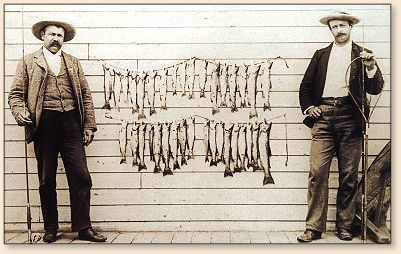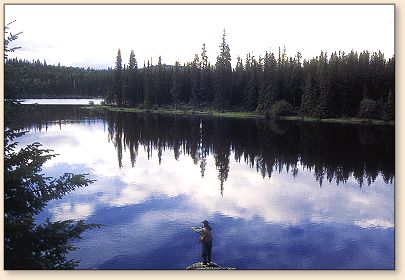Famous British Columbia
Fly-Fishing Waters
By Art Lingren
The Bill Nation Kamloops Area Lakes
IN THE CRADLE OF BRITISH COLUMBIA'S STILLWATER
FLY-FISHERY, Bill Nation is synomymous with the
halycon days of fishing for large rainbow trout
in the lakes around Kamloops. During the 1920s
and 1930s, Nation fished and helped make Lac Le
Jeune, Pinantan, Hyas, Knouff and Paul Lake famous.

Kamloops, an early trading post, grew slowly,
becoming the hub of the Interior in 1885 after
the Canadian Pacific Railway (CPR) reached the
town. It was during the early railway years that
fly-fishers started to explore the lakes in the
area.
Starting in the 1880s and with the good catches
though the 1890s, Fish Lake became the local
fly-fishing hot spot. In 1928, Fish Lake would
be renamed Lac Le Jeune, to recognize Father Le
Jeune's missionary work with the Native people.
Le Jeune with its prodigious population of rainbow
trout drew fly-fishers to its shore and many
provided glowing testimonials on the fishing
they experienced.
Dr. T. W. Lambert devotes over half a chapter
to Fish Lake (Lac Le Jeune) in his valuable
treatise, Fishing in British Columbia
(1907). He writes:
About twenty-three miles from Kamloops is a lake
known as Fish Lake, in which the fishing is so
extraordinary as to border on the regions of romance,
though locally it is considered a matter of course.
For lake fishing, in point of numbers, it is
impossible that this piece of water could be
beaten; it is like a battue in shooting, the
number to be caught is only limited by the skill
and endurance of the angler; indeed, little skill
is needed, for anyone to catch fish there, though
a good fisherman will catch the most. (pp. 48-49)
Lambert also provides a few words about the Natives'
fishery at the lake and of an 1897 catch by an
American friend and himself of 1500 trout in
three days. The "true bait for Fish Lake is
the fly" and about the fly-fishing, fly patterns
and fly sizes, he says:
Flies were abundant, and the fish were ravenous
for both real and artificial; they almost seemed
to fight for our flies as soon as they touched
the water. Even when almost every feather had
been torn off they would take the bare hook. We
fished with three flies, and often had three fish
on at one time...Almost any ordinary Scotch loch
flies are suitable for this water, a brown wing
being perhaps the best, with a red body; the Zulu
is a killing fly, as also a minute Jock Scott,
size being the chief matter of importance. The
fly must not be too large, (p. 51)
Lambert gives an example of a group of fly-fishers
using too large a fly and catching only 30 fish in
a long day's fishing. Those fly-fishers claimed the
lake to be fished out, but Lambert, using smaller
flies, caught 300 the following day.
In the mid 1880s, Dave Lusk, one of Le Jeune's
early sport fishers, built a log cabin on the
lake. He was the first person to make Lac Le
Jeune a fishing retreat. Over the next 100 years
many more would be drawn to the lake's shores to
build summer and permanent homes. Later, in 1905,
he and partner Robert Cowan built the first Fish
Lake Hotel, a primitive but successful hotel, one
of the first fishing-lodge type hotels in the
Interior. Lusk retired in 1906 and Cowan built a
new and larger hotel called the Rainbow Lodge
that became a popular retreat for CPR management
people and other wealthy patrons. The current Lac
Le Jeune resort is located on the same property
that Lusk and Cowan built their first lodge almost
100 years ago.

After a harrowing nighttime journey to get to
"Rainbow Cottage" one of the hotel visitors, F. G.
Aflalo wrote about Lac Le Jeune, which he called
Trout Lake, its fly-fishing, the rainbow's fighting
ability, and fly patterns in Sunset Playgrounds
(1909): For ordinary tastes Trout Lake should be
good enough. I gladly threw back anything under a
pound, and as I may add, as a further tribute to
the fishing, that my action in throwing a trout-fly
is unlike Basonquet's on a slow wicket. Yet at the
very first cast I hooked two, one of close on two
pounds, the other half a pound less. These lake
rainbows jump like tarpon six or eight times, and
they fight like demons...Many flies do well on the
shallows, and among them a red-bodied Montreal, a
green-bodied cow-dung, a March brown, a Zulu, a
Parmachene belle, and a silver doctor, all tied
on No. 5 or 6 hook. (p. 203)
In Rod & Creel in British Columbia (1919),
A. Bryan Williams describes Fish Lake as "the Mecca
for fly-fishermen (p. 114)." It was, and still remains,
a popular fly-fishing lake to this day. Its fame,
however, was to be shaded by some lakes north of
Kamloops: Paul, Pinantan, Hyas and Knouff as well
as Peterhope southeast of Kamloops. These lakes
all had one thing in common. Early settlers
discovered that trout quickly grew to enormous
size when put into barren lakes containing large
populations of aquatic insects. Stocked in 1909
with 5,000 Kamloops trout fry of Scotch Creek
origin, Paul Lake was the first of the barren
lakes to produce very large trout with specimens
weighing between 4 and 14 pounds four years later.
Pinantan Lake, stocked the same year as Paul, is
a smaller, more shallow lake and the fish there
also grew to enormous size. About Paul's and
Pinantan's trout, Williams says that Paul's fish
are "not so plentiful as in Fish Lake but they run
much larger in size" and that Pinantan "has some
enormous trout in it, fish up to twelve and fourteen
pounds have been taken..." (Rod & Creel In
British Columbia, p. 116). Because of the
rapid fish growth and resulting good fishing in Paul
and Pinantan, Knouff was planted in 1917, Hyas in
1923 and Peterhope in the 1935. They would become
renowned in the world of stillwater fly-fishing and
partly so because of one man. ~ Art Lingren
Continued next time.
Credits: From Famous British Columbia Fly-Fishing Waters, published by Frank Amato Publications. We appreciate use permission.
Our Man In Canada Archives
|

